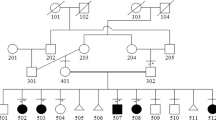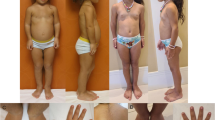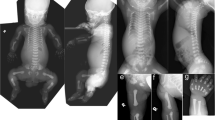Abstract
Pycnodysostosis (OMIM 265800) Is an autosomal recessive skeletal disorder first described by Maroteaux and Lamy1 that is characterized by short stature, increased bone density, delayed closure of cranial sutures, loss of the mandibular angle, dysplastic clavicles, dissolution of the terminal phalanges of the hands and feet, dental abnormalities and increased bone fragility. Patients have a typical appearance secondary to prominence of the calvarium, smallness of the facial features, prominent nose and micrognathia. The French painter, Henri de Toulouse Lautrec (1864–1901), is believed to have had the disorder2. Although more than 100 cases have been reported, we are aware of only two large consanguinous pedigrees in which the pycnodysostosis disorder segregates3–5. We have studied the segregation of the pycnodysostosis phenotype in a large consanguinous Mexican pedigree6, the clinical features of which are very similar to those described in the Arab pedigree studied by Edelson etal.3 Here, we report linkage for the pycnodysostosis phenotype in the 1cen–q21 region of human chromosome 1, and discuss candidate genes for this skeletal disorder.
This is a preview of subscription content, access via your institution
Access options
Subscribe to this journal
Receive 12 print issues and online access
$209.00 per year
only $17.42 per issue
Buy this article
- Purchase on Springer Link
- Instant access to full article PDF
Prices may be subject to local taxes which are calculated during checkout
Similar content being viewed by others
References
Maroteaux, P. & Lamy, M. LaPyknodysostose. Presse Med. 70, 999–1002 (1962).
Maroteaux, P. & Lamy, M. The malady of Toulouse-Lautrec. J. Am. med. Assoc. 191, 715–717 (1965).
Edelson, J.G., Obad, S., Geiger, R., On, A. & Artul, H.J Pyknodysostosis: orthopedic aspects with a description of 14 new cases. Clin. Orthop. 280, 273–276 (1992).
Sedano, H.O., Gorlin, R.J. & Anderson, V.E. Pyknodysostosis: clinical and genetic considerations. Am. J. dis. Child. 116, 70 (1968).
Sugiura, Y., Yama, Y. & Koh, J. Pyknodysostosis in Japan: report of six cases and review of Japanese literature. in Birth Defects, Original Article Series, vol. 10 (Alan R. Liss, New York, 1974).
Cossio Lozano, G.E. Thesis in Medical Genetics, Hospital Infantil de Mexico (1990).
Carmi, R. et al. Use of a DNA pooling strategy to identify a human obesity syndrome locus on chromosome 15. Hum. molec. Genet. 4, 9–13 (1995).
Gyapay, G. et al. The 1993–1994 Généthon human genetic linkage map. Nature Genet. 7, 246–339 (1994).
Yoshida, H. et al. The murine mutation osteopetrosis is in the coding region of the macrophage clony stimulating factor gene. Nature 345, 442–443 (1990).
Lathrop, G.M., Lalouel, J.-M., Julier, C. & Ott, J. Multilocus linkage analysis in humans: detection of linkage and estimation of recombination. Proc. natn. Acad. Sci. U.S.A. 81, 3443–3446 (1984).
Ladner, M.B. et al. Human CSF-1: gene structure and alternative splicing of mRNA precursors. EMBO J. 6, 2693–2698 (1987).
Author information
Authors and Affiliations
Rights and permissions
About this article
Cite this article
Polymeropoulos, M., Ortiz De Luna, R., Ide, S. et al. The gene for pycnodysostosis maps to human chromosome 1cen–q21. Nat Genet 10, 238–239 (1995). https://doi.org/10.1038/ng0695-238
Received:
Accepted:
Issue Date:
DOI: https://doi.org/10.1038/ng0695-238
This article is cited by
-
A Mutation in CTSK Gene in an Autosomal Recessive Pycnodysostosis Family of Chinese Origin
Calcified Tissue International (2015)
-
Cathepsin K analysis in a pycnodysostosis cohort: demographic, genotypic and phenotypic features
Orphanet Journal of Rare Diseases (2014)
-
Next-generation sequencing: a frameshift in skeletal dysplasia gene discovery
Osteoporosis International (2014)
-
Clinical and animal research findings in pycnodysostosis and gene mutations of cathepsin K from 1996 to 2011
Orphanet Journal of Rare Diseases (2011)
-
Cathepsin K: its skeletal actions and role as a therapeutic target in osteoporosis
Nature Reviews Rheumatology (2011)



